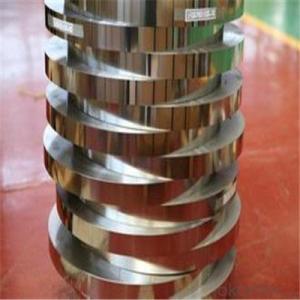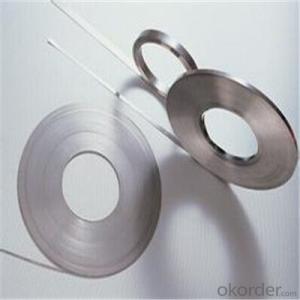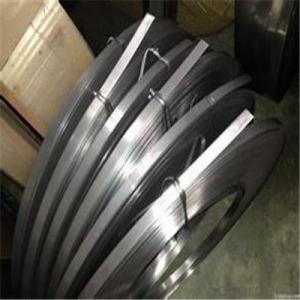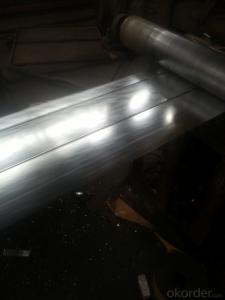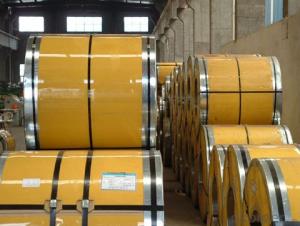Cold Rolled Steel Strip Coils Q195 Q235 in China
- Loading Port:
- Tianjin
- Payment Terms:
- TT OR LC
- Min Order Qty:
- 25 m.t.
- Supply Capability:
- 122222 m.t./month
OKorder Service Pledge
OKorder Financial Service
You Might Also Like
Item specifice
Description of Steel Strip Coils:
Steel strips is one of our main products that is widely used in making band saw blade & other blades to cut paper, weed, etc.
Festures of Steel Strip Coils:
1.Thickness: 0.14-3.0mm
2.width:30-600mm
3.zinc coating: 30-275g
4.material:Q195, Q235,SGCC, A653 CS-B, DX51D,SGCD,SGHC,S350GD,S450GD,S550GD
5.spangle: zero spangle, regular spangle, small spangle
6.surface treatment: chromated and oiled, chromated and non-oiled
7.packing: export standard packing
8.Payment: TT or L/C
9.MOQ: 25TON
10.coil weight: 3-4ton
11.quality: soft or hard quality
Specifications of Steel Strip Coils:
| Description | Hot Rolled Steel Strip |
| Brand | Tianjin Metallurgical No.Steel Group |
| Specification | 1.2-6.0mm*70mm |
| Standard | AISI,ASTM,BS,DIN,GB,JIS |
| Material | Q195,Q215,Q215B,Q235,Q235B |
| Application | Widly used in welding steel pipes, and bicycle making etc. |
| Certificates | BV,SGS,ISO etc. |
| MOQ | 20 tons or according to customers’ requirement. |
| Port of Delivery | Tianjin Port of China |
| Remarks | We can provide qualify goods,competitive price and speedy delivery |
Images of Steel Strip Coils:
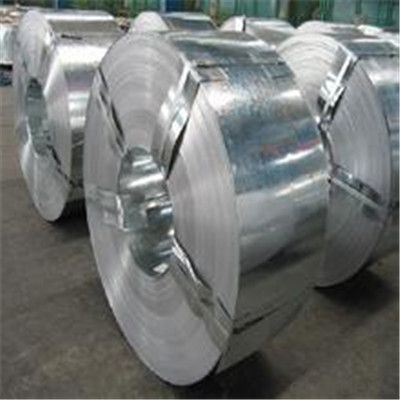
FAQ
1.What's your MOQ?
25MT, it is for one container.
2.Do you have QC teams?
Yeah, sure, our QC team is very important, they will keep the quality control for our products.
3. What's your normal delivery time?
Our delivery time about 10-20days for standard sizes, if you have other requirements like hardness and width ,it is about 20-40days.
- Q:What are the common thickness variations in steel strips?
- The thickness of steel strips can vary depending on the industry and application. Generally, steel strips are manufactured with a tolerance range for thickness to account for variations during production. The most common way to measure thickness variations in steel strips is by gauge or thickness range. Gauge refers to the thickness of a steel strip, with lower numbers indicating thicker strips and higher numbers indicating thinner strips. For instance, in the automotive industry, steel strips used for structural components may have a tolerance of ±0.005 inches (0.13 mm) or less. This ensures that the strips meet the required strength and performance specifications while maintaining consistency in production. In other industries like construction or manufacturing, steel strips may have slightly larger thickness variations depending on the application. These variations can range from ±0.010 inches (0.25 mm) to ±0.020 inches (0.51 mm) or more, depending on the project's specific requirements. It's important to note that these thickness variations are carefully controlled and specified by industry standards and regulations. Manufacturers utilize advanced technology and quality control measures to ensure that steel strips are produced within the required tolerance range to meet desired specifications. Overall, while there may be slight thickness variations, steel strips are typically controlled within specific tolerance ranges to ensure consistency, quality, and performance in various applications.
- Q:How do steel strips handle bending or forming operations?
- Steel strips are highly versatile and can handle bending or forming operations with ease. Due to their inherent strength and flexibility, steel strips can be easily manipulated and shaped into various forms without compromising their structural integrity. Additionally, steel strips have excellent ductility, allowing them to withstand repeated bending and forming operations without breaking or deforming.
- Q:How are steel strips used in the railway sector?
- Steel strips are used in the railway sector for a variety of purposes, including the manufacturing of rails, tracks, and various components of the railway infrastructure. They provide strength, durability, and stability to ensure the safe and efficient movement of trains.
- Q:The degreasing time is too long, will the strip surface be oxidized?
- Galvanized steel plate in spray, generally do phosphating treatment, the parameters of free acid phosphating solution should be kept low, and high temperature, acid, zinc ions reduced excessive reaction, resulting in coarse crystallization. Reference: Fa:0.8-1.5 Ta:17-28 acid ratio of about 25, the temperature can be 35-45 degrees.
- Q:How do steel strips contribute to product cost-effectiveness in various applications?
- Steel strips contribute to product cost-effectiveness in various applications primarily due to their durability, versatility, and cost-efficiency. As a highly durable material, steel strips offer long-lasting performance, reducing the need for frequent replacements or repairs. Their versatility allows for customization and adaptation to various applications, eliminating the need for multiple materials. Additionally, steel strips are cost-efficient in terms of production, transportation, and installation, making them a cost-effective choice for a wide range of industries and products.
- Q:How do steel strips respond to different surface painting processes?
- Steel strips respond differently to different surface painting processes depending on the specific method used. The surface painting processes commonly used on steel strips include electroplating, powder coating, and liquid paint application. Electroplating is a process where a layer of metal is deposited onto the steel strip surface using an electric current. This method provides excellent corrosion resistance, as the metal layer acts as a protective barrier. However, it may not be suitable for all applications as it can impact the mechanical properties of the steel strip. Powder coating involves applying a dry powder to the steel strip surface, which is then heated to create a chemical reaction that forms a durable and protective coating. This process is known for providing excellent adhesion, resistance to chipping, scratching, and fading. It also offers a wide range of colors and finishes, making it popular in various industries. Liquid paint application involves the use of a liquid paint that is applied to the steel strip surface using different techniques such as spraying, brushing, or dipping. This method allows for a high level of customization in terms of colors, finishes, and textures. However, it may not provide the same level of durability and resistance as powder coating. Overall, the response of steel strips to different surface painting processes depends on factors such as the intended application, desired appearance, and required level of protection. It is essential to consider these factors and consult with professionals in the field to determine the most suitable painting process for steel strips in a specific application.
- Q:How are the health risks minimized during steel strip production?
- In steel strip production, various measures are taken to minimize health risks and ensure the safety of workers. These measures can be categorized into three main areas: engineering controls, administrative controls, and personal protective equipment (PPE). Firstly, engineering controls involve designing and implementing systems to control and minimize potential health hazards. This includes effective ventilation systems that remove airborne contaminants and maintain a clean and safe working environment. Local exhaust ventilation is often used to capture and remove fumes, dust, and gases generated during various steel processing operations. By effectively controlling the emission of hazardous substances, the risk of exposure to harmful substances is significantly reduced. Secondly, administrative controls involve implementing procedures and practices to minimize health risks. Regular monitoring and maintenance of equipment and machinery is crucial to ensure their proper functioning and minimize the release of hazardous substances. Proper training and education of workers regarding potential health hazards and safe work practices are also important. This empowers workers to identify and report any potential risks, as well as follow appropriate safety protocols. Additionally, strict adherence to safety regulations and standards, such as those set by regulatory authorities and industry organizations, helps mitigate health risks during steel strip production. Lastly, personal protective equipment (PPE) plays a vital role in reducing health risks. Workers are provided with appropriate PPE, such as respirators, safety glasses, gloves, and protective clothing, to protect them from exposure to hazardous substances and physical hazards. PPE should be properly fitted, regularly inspected, and replaced as necessary to ensure its effectiveness in minimizing health risks. Overall, by implementing engineering controls, administrative controls, and providing appropriate PPE, health risks during steel strip production can be minimized. Regular monitoring, training, and adherence to safety procedures also contribute to a safe working environment for all workers involved in the steel production process.
- Q:What are the advantages of using steel strips?
- There are several advantages of using steel strips. Firstly, steel strips are known for their high strength and durability, making them suitable for various applications that require robust materials. Secondly, steel strips have excellent corrosion resistance, ensuring their longevity even in harsh environments. Additionally, steel strips can be easily formed and manipulated, allowing for customization and versatility in different industries. Lastly, steel strips are highly recyclable, making them a sustainable choice and contributing to environmental conservation efforts.
- Q:How are steel strips used in the production of electrical conductors?
- Due to their exceptional electrical conductivity and mechanical properties, steel strips are commonly utilized in the manufacturing of electrical conductors. These strips act as the fundamental structure or core of the conductor, providing both strength and support. To enhance conductivity, steel strips are typically coated with a layer of copper or aluminum during the manufacturing process. This is accomplished using various techniques such as electroplating or hot dipping. The coating assists in reducing electrical resistance and enhancing the flow of electric current through the conductor. In the production of transformer windings, steel strips are also employed. Transformers are vital in the transmission and distribution of electricity, and the steel strip serves as the central component around which copper or aluminum wire is wound. The steel core ensures stability of the windings, preventing displacement and enabling proper insulation. Furthermore, steel strips find application in the production of overhead power lines. These power lines are responsible for carrying substantial amounts of electrical current over long distances, and steel strips are used as the core material for the conductors. By providing mechanical strength, the steel core prevents sagging of the power lines, ensuring efficient electricity transmission. In conclusion, steel strips are indispensable in the production of electrical conductors due to their electrical conductivity, mechanical strength, and ability to support and enhance conductor performance.
- Q:What are the specifications for tolerance in steel strips?
- The specifications for tolerance in steel strips typically depend on the specific application and industry standards. However, commonly used tolerance specifications for steel strips can include factors such as thickness, width, straightness, and surface quality. These specifications ensure that the steel strips meet the required dimensional and quality requirements for their intended use.
1. Manufacturer Overview |
|
|---|---|
| Location | |
| Year Established | |
| Annual Output Value | |
| Main Markets | |
| Company Certifications | |
2. Manufacturer Certificates |
|
|---|---|
| a) Certification Name | |
| Range | |
| Reference | |
| Validity Period | |
3. Manufacturer Capability |
|
|---|---|
| a)Trade Capacity | |
| Nearest Port | |
| Export Percentage | |
| No.of Employees in Trade Department | |
| Language Spoken: | |
| b)Factory Information | |
| Factory Size: | |
| No. of Production Lines | |
| Contract Manufacturing | |
| Product Price Range | |
Send your message to us
Cold Rolled Steel Strip Coils Q195 Q235 in China
- Loading Port:
- Tianjin
- Payment Terms:
- TT OR LC
- Min Order Qty:
- 25 m.t.
- Supply Capability:
- 122222 m.t./month
OKorder Service Pledge
OKorder Financial Service
Similar products
New products
Hot products
Related keywords
